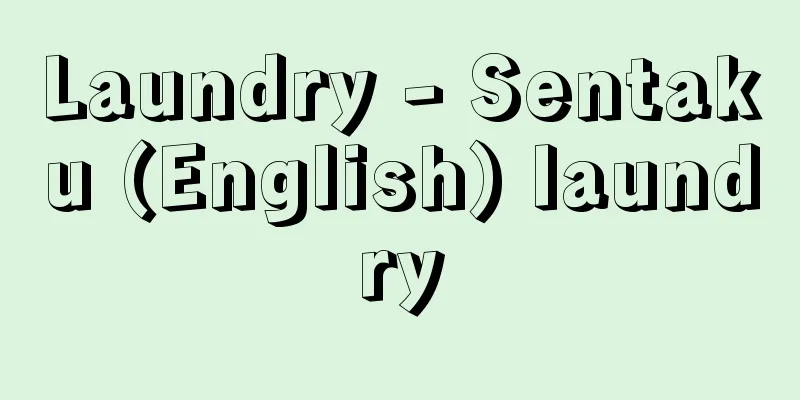Laundry - Sentaku (English) laundry

|
Washing off dirt from clothes, etc. In the past, it was also called sendaku, and for a long time it was a large part of housework, a job done by women. However, with the spread of electric washing machines due to household electrification, and the appearance of new synthetic fibers and new detergents, the time and effort spent on laundry has been significantly streamlined. [Shigeru Ochiai] historyLaundry began as clothes became valuable after passing the stage of being worn and discarded, but the initial motivation was religious. Just as with bathing to purify the body, ancient people considered impurity to be a sin, just like evil or disaster, and strived to be clean before God. In the Old Testament, Moses had people wash their clothes before receiving the Ten Commandments on Mount Sinai, and the Isuzu River (Ise City, Mie Prefecture) was named Mimosuso River after the story of Yamatohime-no-Mikoto washing the dirt from her tabakama (sash). These are manifestations of this purification before the gods. In China, Sima Qian's Records of the Grand Historian states that washing clothes was done out of ethical motives as a way of serving one's parents. Similarly, samurai in the Kamakura period always wore well-washed and well-maintained clothes as a sign of their integrity towards their lord. Homer's Odyssey describes women washing clothes at a beautiful riverside washing area, and while waiting for the clothes to dry, they bathe, eat, and play ball games. The Hitachi no Kuni Fudoki (Hitachi no Kuni Fudoki) (713-715) also describes village women playing and having fun washing clothes by a spring well. For ancient people, rivers were natural water sources and bathtubs, and both washing and bathing began at the waterside. Primitive washing methods changed from leaving clothes in the flow of the river to soaking clothes in water drawn from springs, swamps, and wells. Eventually, as soaking alone was not enough to remove dirt, methods such as rubbing, shaking, and stepping with hands and feet, as well as beating, pressing, and rubbing with boards using natural objects such as wooden sticks and stones, were added. After it was discovered that heating water improves the cleaning power, boiling and steaming methods were also used. The rock tomb murals of Beni Hassan in Egypt, said to date back to around 200 BC, depict the washing process of beating, stomping, rinsing, wringing, and drying cloth. In ancient Egypt, the hieroglyph for the word "washing" was expressed as two feet in water, which shows that stomping was the common washing method at the time. When laundry rooms moved indoors or outdoor wells began to be used, wash tubs appeared in the West and basins (meaning hand-washing) appeared in Japan. The difference between basins and basins comes from the difference between standing and sitting lifestyles, and also from the difference between Western clothes, which are made with curves and need to be washed, and Japanese clothes, which are made with straight lines and can be taken apart and washed. In Japan, washing in a basin while bending over continued for a long time, but basins appeared in the Heian period, and old fan-shaped sutras from that time often depict people washing clothes by stomping on them at the edge of a well. This was because the fibers of clothing at that time were thicker, and from the end of the Heian period to picture scrolls of the Kamakura and Muromachi periods, hand-washing in a basin became more common. Furthermore, in the Muromachi period, dyers also worked on washing and stretching clothes. In the Edo period, when the townspeople class rose to power, washable cotton became the clothing of the common people, promoting the spread of laundry. When people who worked as laundromatologists appeared, they were called laundry people (maru-arai) in Edo and laundry people (hira-arai) in Kyoto. [Shigeru Ochiai] The washing principleThere are two methods of washing clothes: washing with detergent (wet washing) and dry cleaning with solvents (dry washing), with most washing done at home being wet washing. Stains on clothes can be broadly divided into three types: dry (dirt, soil, etc.), water-based (sweat, etc.), and oil-based (cosmetics, edible oils, etc.). The principle by which stains are removed by washing is either the physical action of kneading and beating, or the chemical action of detergent dissolving the stain in water, and these two methods are used in combination. Dry stains are removed with a brush, and water-based stains are washed with water, taking advantage of their solubility in water. Water with dissolved soap or detergent has low surface tension, so it quickly penetrates the fibers of the fabric, softening the stain and making it easier to remove. Oily stains, which are less compatible with water, are dispersed into small particles by emulsification and removed from the surface of the fibers. The physical action of shaking the laundry further promotes these cleaning actions of penetration, adsorption, emulsification, and dispersion. [Shigeru Ochiai] detergentSoap, synthetic detergents, alkaline agents, dry cleaning solvents, etc. are used for laundry, but in the past, acid clay, crushed lupine fruit, plant ash and lye were commonly used, and sand was used especially in areas with a lack of water. As can be seen from the remains of a soap factory in the ruins of Pompeii, soap was already being made in Rome around the 1st century. The soap industry emerged in Italy, Spain, and Marseilles in France around the 12th century, and then spread throughout Europe by the 15th century. In Japan, honey locust, soapberry fruit, lye, rice water, and adzuki bean powder have long been used for laundry, and ukiyo-e and other art show that lye was the main ingredient. Shabon (soap) was brought to Japan by Nanban ships in the 16th century, but at the time it was mainly used for medicinal purposes. It was not until around 1877 (Meiji 10) that domestically produced soap became available that it began to be used for laundry in general. Soap is suitable for cotton and linen products, but its effectiveness decreases in hard or cold water, and it has the drawback of damaging the texture and color of fabrics such as wool and silk that are sensitive to alkali. To address these disadvantages, a neutral synthetic detergent, a higher alcohol-based detergent called higher alcohol sulfate, was first developed and industrialized in Germany in 1928. Then, soapless soap, which is made from petroleum and contains sodium alkylbenzene sulfonate (hard type ABS) as its main ingredient, was industrialized in the United States in the 1930s, but this is difficult to decompose and the wastewater causes pollution such as foaming in rivers, so it was replaced by sodium alkylbenzene sulfonate (soft type LAS), which is more easily biodegradable. In addition, phosphorus was added to detergents as a cleaning promoter (builder), but phosphorus-free detergents were developed due to the problem of eutrophication in closed lakes and ponds. Other laundry aids used include washing soda, sodium silicate, sodium sesquicarbonate (a combination of sodium bicarbonate and sodium carbonate), ammonia water, acids, and softeners such as turmeric oil (Turkish red oil) and glycerin. Laundry detergents are divided into neutral light-duty detergents for light stains and weakly alkaline heavy-duty detergents for heavy stains, depending on the hydrogen ion concentration (pH). Light-duty detergents are for delicate fabrics such as wool and silk, which are weak to alkali, or acetate, while heavy-duty detergents are for practical fabrics such as cotton, linen, rayon, and vinylon. Natural water, which contains a lot of salts such as calcium and magnesium, does not dissolve soap well and does not foam well compared to rainwater or tap water, and is not suitable for washing. [Shigeru Ochiai] Home laundryIt is reasonable to follow the following steps when washing clothes at home. (1) Classification: Classify the laundry according to its type, fiber, and the degree of dirt. (2) Soaking: Soak in cold or lukewarm water before washing to remove dirt. (3) Pre-wash: Pre-wash in water or an alkaline solution before the main wash. (4) Main wash: Wash using detergent appropriate for the dirt and fiber. Can be hand washed or machine washed. Machine washing removes dirt evenly, but hand washing can be adjusted depending on the heavily soiled areas and the strength of the fabric. (5) Rinse: Rinse with water changed at least three times to remove absorbed detergent. Can be soaked or rinsed under running water. (6) Spin-drying: Can be done by hand wringing or by using a centrifuge. (7) Drying: Can be done naturally or artificially. Avoid direct sunlight for items that will yellow or fade when dried naturally. Artificial drying can be done in a short time regardless of the weather, so it is convenient in areas with insufficient sunlight or where there is severe air pollution from soot, etc. (8) Finishing: Use an iron, but for wool or synthetic fibers, it is best to place a piece of cloth over the fabric. After unraveling and washing the kimono fabric, it is laid on a board or a stretcher. Other methods include bleaching with bleach, brightening with fluorescent dyes, and applying starch. [Shigeru Ochiai] Various laundry methodsThe main washing methods are as follows: (1) Rub-washing: Suitable for white cotton or linen fabrics. (2) Scrubbing: Washing is done by rubbing the fabric against a washboard, so it is not suitable for weak fabrics. (3) Brush-washing: Used for particularly dirty areas or areas that cannot be washed by rubbing. (4) Grab-washing: This method does not damage the fabric, and is suitable for silk, wool, and synthetic fibers. (5) Press-washing: Repeatedly pressing the palm of the hand against the washboard and then releasing it, suitable for rayon and wool, which have weak structures. (6) Shake-washing: Suitable for large, sturdy items that cannot be washed freely by hand. (7) Stomp-washing: Large items such as blankets are stepped on in a bathtub or on a concrete floor. (8) Beating-washing: Washing is done by beating with a beating stick or similar object while applying detergent. (9) Spatula-washing: Heavily soiled tabi soles are washed by scrubbing with a spatula dipped in detergent. (10) Hot water washing - This is done to finish white cotton, linen, and other materials that can withstand heat to a pure white color. [Shigeru Ochiai] Commercial laundryDry cleaning refers to laundry done by a professional laundromat, as opposed to home laundry. The appearance of laundries dates back to Roman times, with guilds of laundromats already established in 13th-century England and public laundries established in 19th-century Western Europe. Dry cleaning, which uses volatile solvents to remove stains from clothing, became popular throughout Europe after the French scientist Bren announced a waterless washing method using benzene in 1847. As Western clothing became more widespread in Japan, Western laundries appeared, and dry cleaning began at the end of the Meiji period. Most of Japan's laundry industry combines laundries, which use water, with dry cleaning, which uses solvents, and there are approximately 47,300 such establishments (as of 1999). Most of these are small-scale establishments with four employees or less, and there are only a few large factories. There are also approximately 115,700 agent establishments that do not perform laundry services. In addition to laundry factories run by hotels and hospitals, there are also linen supply businesses that rent sheets, uniforms, and other items to hotels and restaurants. The process of factory laundry is as follows: (1) Marking - attaching customer name tags to items. (2) Sorting - sorting according to the washing method, fiber material, processing, and dyeing. (3) Washing - washing with water, detergent, and auxiliary agents in a rotary washing machine. (4) Spin-drying - squeezing out water in a high-speed centrifuge. (5) Press finishing - finishing using a press machine, the dehydrated items are pressed as they are as they are, as they also dry. Used for shirts, work clothes, white robes, yukata, trousers, etc. (6) Roll finishing - finishing by passing the items between rollers that rotate horizontally on a curved surface heated by steam, used for flat items such as sheets and tablecloths. (7) Ironing - in the past, ironing was the predominant method of finishing, but nowadays it is used as an auxiliary method for areas where pressing alone is insufficient, or for finishing small items such as tabi and collars. (8) Cabinet-type shirt finishing - A machine that puts the shirt on a form and presses the body from both sides with steam-heated hot plates, and a machine that presses the sleeves and shoulders is used to finish the shirt efficiently. (9) Drying. (10) Inspection. (11) Sorting. (12) Shipping. [Shigeru Ochiai] [Reference] | | | | | | | |A person is washing clothes by stepping on a split bamboo-shaped stone while pouring water from a bucket with a ladle. "Shigisan Engi Emaki" (A copy of the National Diet Library ) Stomp washing Washing clothes by pounding them with a vertical pestle in a narrow mortar on the banks of the Tama River. "Tamagawa in Chofu, Musashi Province," by Utagawa Kuniyoshi, owned by the National Diet Library . Rubbing Source: Shogakukan Encyclopedia Nipponica About Encyclopedia Nipponica Information | Legend |
|
衣類などについた汚れを洗い落とすこと。古くは洗濁(せんだく)ともいい、女性の仕事として長い間家事労働の大きな部分を占めてきたが、家庭電化による電気洗濯機の普及、新しい化学繊維や新洗剤の出現などにより、洗濯に費やす時間と労力は著しく合理化された。 [落合 茂] 歴史洗濯は、衣服が着捨ての段階を経たのち貴重価値を生じるにつれて始められたが、最初の動機は宗教心に発していた。体を水に清める沐浴(もくよく)と同様、古代人は穢(けがれ)も罪悪や災害と等しく罪とみなして、神の前で清潔であることに努めた。『旧約聖書』のモーゼが、シナイ山で十戒を授かる前に人々に衣服を洗わせたのも、あるいは倭姫命(やまとひめのみこと)が裳(たばかま)の汚れを洗ったという故事から五十鈴(いすず)川(三重県伊勢(いせ)市)が御裳(みもすそ)川とよばれたのも、この神前潔斎の現れである。また中国では司馬遷(しばせん)の『史記』に、父母に仕える道として倫理的動機から洗濯を行ったとあり、同じように主君への清廉潔白を表すものとして、鎌倉時代の武士はつねに洗濯の手入れの行き届いた衣服を着用した。 ホメロスの『オデュッセイア』には、美しい川辺の洗い場で女たちが洗濯をし、乾くまでの間、水浴、食事、まり遊びなどをしているようすが描かれている。また『常陸国風土記(ひたちのくにふどき)』(713~715)には、湧(わき)井戸のほとりで村の女たちが遊び楽しみながら洗濯をする記述があるように、古代人にとって川は自然の水道、浴槽であり、洗濯も沐浴もまず水辺から始まった。原始的な洗濯は、川の流れにさらす方法から泉、沼、井戸の汲(く)み水を使って浸す方法へと変わった。やがて、浸すだけでは汚れが落ちにくいところから、手や足の操作によるもみ洗い、振り洗い、踏み洗い、さらに木の棒や石などの自然物を利用するたたき洗い、押し付け洗い、板もみ洗いなどが加わった。また水を加熱することにより洗浄力が高まることを知ってからは、煮洗いや蒸し洗いも行われるようになった。紀元前200年ごろのものといわれるエジプトのベニ・ハッサンの岩墓(がんぼ)壁画には、布をたたき、踏み、すすぎ、絞り、乾かすという洗濯作業のようすが描かれている。古代エジプトでは洗濯ということばの象形文字が、水の中の2本の足で表現されていたことから、当時は踏み洗いが一般的な洗濯方法であったことがわかる。 洗濯場が屋内に移ったり、屋外の井戸端が使われるようになると、西洋では洗濯桶(おけ)wash tubが、日本ではたらい(手洗いの意)が登場した。桶とたらいの相違は立ち居と座居の生活様式の差からきており、また衣服そのものが曲線的な仕立てで丸洗いを必要とする洋服と、直線的な仕立てで解き洗いができる和服との違いにも由来している。日本では、かがんだ姿勢のたらい洗いが長く続いたが、たらいの出現は平安時代で、当時の扇面古写経には井戸端での足踏み洗いがよく描かれている。これは当時の衣料繊維が太かったためで、平安末期から鎌倉・室町時代の絵巻物になると、たらいでの手もみ洗いのほうが多くなっている。さらに室町時代には、染師が洗い張りや伸子(しんし)張り仕上げを兼業した。町人階級が台頭する江戸時代になると、洗濯のきく木綿が庶民の衣料となって洗濯の普及を促した。洗濯を職業とする者が現れると、江戸では洗濯屋(丸洗い)、京都では洗い物屋(解き洗い)とよばれた。 [落合 茂] 洗濯の原理洗濯の方法には、洗剤を用いての水洗い(湿式洗濯)と、溶剤によるドライクリーニング(乾式洗濯)があり、家庭で行われるのはほとんどが湿式である。また衣料につく汚れは大きく分けて、乾性(ごみや土砂など)、水性(汗など)、油性(化粧品や食用油脂など)の三つに分けられる。洗濯によって汚れが除去される原理は、もんだりたたいたりする物理的作用と、洗剤によって汚れを水に溶かす化学的作用によるものとがあり、この二つが併用されている。 乾性の汚れはブラシなどで取り除き、水性の場合には水の溶解性を利用して水洗いする。せっけんや洗剤の溶けた水は表面張力が低いので、布地の繊維に速やかに浸透して汚れをふやかし、汚れを除きやすくする。また水に親しみにくい油性の汚れは、乳化作用によって小さい粒子に分散し、繊維の表面から取り除かれる。さらに洗濯物を振り動かす物理的な作用が加わり、これら浸透、吸着、乳化、分散の洗浄作用が促進される。 [落合 茂] 洗剤洗濯にはせっけん、合成洗剤、アルカリ剤、ドライクリーニング溶剤などが使われているが、古くは酸性白土や砕いたルピナスの実、植物の灰や灰汁(あく)などが一般に用いられ、とくに水の乏しい地方では砂が洗濯に用いられていた。ポンペイの遺跡のせっけん工場跡からわかるように、1世紀ごろのローマではすでにせっけんがつくられていた。そして12世紀ごろにはイタリア、スペイン、およびフランスのマルセイユでせっけん業がおこり、それから15世紀にかけてヨーロッパ各地に広がった。日本では古くからサイカチ、ムクロジの実、灰汁、米のとぎ汁、澡豆(そうず)(アズキの粉)などが洗濯に用いられ、なかでも灰汁がおもに使われていたことは浮世絵などからわかる。シャボン(せっけん)は16世紀に南蛮船によってもたらされたが、当時はおもに薬用にあてられ、一般に洗濯に用いられるようになったのは1877年(明治10)前後に国産せっけんが出回るようになってからのことである。 せっけんは綿や麻製品などには適しているが、硬水や冷水では効果が低下し、また羊毛や絹などのアルカリに弱い布の生地(きじ)や色合いを損なうという欠点がある。そこで、それらの不都合を補うような中性の合成洗剤、つまり高級アルコール硫酸塩とよばれる高級アルコール系洗剤が、1928年に初めてドイツで開発、工業化された。ついでアルキルベンゼンスルホン酸ソーダ(ハード型ABS)を主成分とする石油を原料としたソープレスソープが、1930年代にアメリカで工業化されたが、これは分解されにくく、しかも廃水が河川の発泡などの汚染を招くため、さらに生分解されやすいアルキルベンゼンスルホン酸ナトリウム(ソフト型LAS)へと転換された。また洗剤には洗浄促進剤(ビルダー)としてリンが配合されていたが、閉鎖性湖沼の富栄養化問題から、無リン洗剤が開発された。このほか洗濯補助剤として洗濯ソーダ、ケイ酸ソーダ、セスキ炭酸ソーダ(炭酸水素ナトリウムと炭酸ソーダの結合したもの)、アンモニア水、酸類、柔軟剤としてロート油(トルコ赤油)、グリセリンなどが用いられている。 衣料用洗剤は水素イオン濃度(pH)により、軽い汚れを対象とする中性の軽質洗剤(ライトデューティー)と、ひどい汚れを対象とする弱アルカリ性の重質洗剤(ヘビーデューティー)に分けられる。軽質洗剤はアルカリに弱い毛や絹、あるいはアセテートなどのおしゃれ着用に、重質洗剤は木綿や麻、レーヨン、ビニロンなどの実用着用にと、繊維の性質や汚れの程度によって使い分ける必要がある。なお、カルシウムやマグネシウムなどの塩分を多く含む天然の水は、雨水や水道の水に比べてせっけんの溶けぐあいも泡立ちも悪く、洗濯に適さない。 [落合 茂] 家庭での洗濯家庭での洗濯は次の手順で行うのが合理的である。(1)分類―洗濯物を種類、繊維、汚れの多少などにより分類する。(2)水つけ―洗濯前に水または微温湯(ぬるまゆ)につけて、汚れ落ちをよくする。(3)下洗い―本洗い前に水またはアルカリ剤液中で下洗いする。(4)本洗い―汚れや繊維に応じた洗剤による洗濯で、手洗いと機械洗いがある。洗濯機洗いは汚れが均一にとれるが、手洗いは汚れのひどい部分や布地の強弱によって加減ができる。(5)すすぎ―吸着した洗剤を除去するため、少なくとも3回以上水をかえてすすぎを行う。ためすすぎと流しすすぎがある。(6)脱水―手絞りと遠心分離機による方法がある。(7)乾燥―自然乾燥と人工乾燥がある。自然乾燥で黄変、変退色するものは直射日光を避ける。人工乾燥は天候に左右されずに短時間で乾燥できるので、日照の不十分な地域や、煤煙(ばいえん)などで空気汚染が著しい場合に便利である。(8)仕上げ―アイロンを使うが、毛や化学繊維には布1枚をあてがってかけるとよい。和服地を解き洗いしたものは板張りや伸子(しんし)張りにする。そのほか、漂白剤による漂白、蛍光染料による増白、糊(のり)つけなどがある。 [落合 茂] 洗濯のいろいろおもな洗濯の方法には次のようなものがある。(1)もみ洗い―木綿や麻の白地物に適する。(2)こすり洗い―洗濯板にこすりつけて洗うので、弱い布地には適さない。(3)刷毛(はけ)洗い―とくに汚れのひどい部分や、もみ洗いのできない部分に行う。(4)つかみ洗い―布地を痛めない方法で、絹、毛、化繊に適する。(5)押し付け洗い―洗濯板の上に手のひらで押し付けては離す動作を繰り返す方法で、組織の弱いレーヨンや毛に適する。(6)振り洗い―手で自由に洗えないような、生地がじょうぶで大きな物に適する。(7)踏み洗い―毛布などの大きなものを風呂桶(ふろおけ)やコンクリート床で踏んで行う。(8)たたき洗い―たたき棒などで洗剤をつけながらたたいて洗う。(9)へら洗い―汚れのひどい足袋(たび)底などを、洗剤液をつけたへらでしごいて洗う。(10)熱湯洗い―熱に耐えられる白木綿や麻などを純白に仕上げるために行う。 [落合 茂] 営業洗濯家庭洗濯に対して、洗濯業者が行うものをいう。洗濯業者の出現はローマ時代にまでさかのぼり、13世紀のイギリスにはすでに業者のギルド(組合)が、19世紀の西欧諸国には公共洗濯所が設けられていた。揮発性溶剤を用いて衣料の汚れを落とすドライクリーニングは、1847年フランスのブレンがベンゼンによる無水洗濯法を発表後、ヨーロッパ各地に普及した。 日本では洋服の普及とともに西洋洗濯屋が登場し、明治末年からドライクリーニングが始まった。日本の洗濯業界はほとんどが、水を用いるランドリーと、溶剤を用いるドライクリーニングの兼業で、約4万7300軒(1999年度)を数えるが、その多くは従業員4人以下の小規模なもので、大工場は数社にすぎない。また、洗濯業務を行わない取次店は約11万5700軒である。さらにホテルや病院が自営する付属洗濯工場のほかに、ホテルやレストランにシーツやユニホームなどを賃貸するサービス業として、リネンサプライ業がある。 工場洗濯の作業工程は次のとおりである。(1)マーキング―品物に客の名札をつける。(2)分類―洗濯方式に応じて、繊維の素材や加工、染色により分類する。(3)洗濯―回転洗濯機で水、洗剤、助剤を用いて洗う。(4)脱水―高速回転の遠心分離機で水を絞り取る。(5)プレス仕上げ―プレス機を用いての仕上げで、乾燥を兼ねているため脱水したものをそのままプレスする。ワイシャツ、作業衣、白衣、浴衣(ゆかた)、ズボンなどに用いる。(6)ロール仕上げ―蒸気で加熱された曲面上に、横に回転するローラーの間を通して仕上げるもので、シーツ、テーブルクロスなど平らなものに用いる。(7)アイロン仕上げ―古くは仕上げといえばアイロン仕上げが大部分であったが、現在はプレス機だけでは不十分な部分の補助手段として、あるいは足袋やカラーなどの小物仕上げに用いる。(8)キャビネット型ワイシャツ仕上げ―ワイシャツを型に着せ、胴部分を蒸気加熱した熱板で両面からプレスする装置で、袖(そで)や肩をプレスする機械を組み合わせてユニットにしたものを使い、能率的に仕上げる。(9)乾燥。(10)検査。(11)整理。(12)発送。 [落合 茂] [参照項目] | | | | | | | |割竹形の石の上で、桶の水を柄杓でかけながら足踏み洗濯をするようす。『信貴山縁起絵巻』 写国立国会図書館所蔵"> 踏み洗い 多摩川の川辺で、くびれ臼に竪杵での搗{つ]き洗い洗濯。歌川国芳画『武蔵国調布の玉川』国立国会図書館所蔵"> 搗き洗い 出典 小学館 日本大百科全書(ニッポニカ)日本大百科全書(ニッポニカ)について 情報 | 凡例 |
Recommend
IUCN - International Union for Conservation of Nature
International Union for Conservation of Nature and...
Americaine (France)
In French cuisine, this term is used for American-...
Gasteria
…All species are small and neat, and can grow ind...
Azuma Mondo
A Muromachi period treatise on renga. Also known a...
Hampton, C.
...The same tendency can be seen in modern works,...
Sean O'Casey
Irish playwright. Born as the youngest child of a...
Fujiyoshi Setoguchi
Conductor and composer. Born in Kagoshima Prefect...
Limonium bonduellii (English spelling)
… [Eiichi Asayama]. … *Some of the terminology th...
science and technology
...In the administrative term "science and t...
Gheorghe Şincai (English spelling)
1754‐1816 A Romanian historian and linguist from T...
Inahiko Hashimoto
Year of death: 15th June 1809 (27th July 1809) Yea...
The Overseas Economic Cooperation Fund
Founded in March 1961 under the Overseas Economic...
Motivation - Iiyoku
〘noun〙① The desire to do something. The will to do...
Santa Maria di Capua Vetere (English spelling)
…A town in southern Italy that flourished during ...
AWSA - AWSA
…Initially, they tried to realize women's suf...




![Marii-El [Republic] (English spelling)](/upload/images/67cceb279e0f5.webp)




